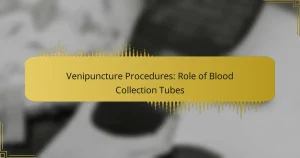Venipuncture is a critical skill for healthcare professionals, involving various techniques to safely and effectively draw blood. In Canada, methods such as the butterfly needle technique, the Vacutainer method, and direct venipuncture are commonly used, each tailored to specific patient needs and clinical scenarios. Understanding the factors influencing technique selection is essential for minimizing discomfort and ensuring successful outcomes.
Butterfly vs Straight Needles: Which Is Better and When to Use
When it comes to sewing, choosing between butterfly and straight needles can significantly impact your project outcomes. Butterfly needles are particularly suited for tasks like quilting and embroidery, offering enhanced…
State Regulations for Venipuncture Certification: Key Compliance Factors
Venipuncture certification in Canada is governed by provincial regulations, leading to variations in requirements across different regions. To achieve certification, healthcare professionals must complete an accredited training program and successfully…
Venipuncture: Importance of Site Selection and Techniques
Venipuncture is a critical procedure in healthcare, where the selection of the appropriate site significantly impacts the success of blood draws and the quality of samples obtained. Effective site selection…
Venipuncture Techniques: Efficacy, Challenges and Solutions in Home Healthcare
Venipuncture techniques in home healthcare are crucial for ensuring effective blood draws while prioritizing patient comfort and safety. By employing methods such as butterfly needles and proper site selection, caregivers…
Venipuncture Training Course: Selection Criteria and Career Goals
Venipuncture training courses are essential for those looking to enhance their skills in blood collection and patient care within the healthcare field. Key selection criteria include program accreditation, instructor qualifications,…
Online vs In-Person Venipuncture Training: Pros and Cons
When considering venipuncture training, individuals face the choice between online and in-person formats, each with distinct advantages and disadvantages. Online training offers convenience and flexibility, making it an attractive option…
Venipuncture: Cultural Sensitivity, Patient Comfort and Compliance
Venipuncture is a critical procedure in healthcare that requires cultural sensitivity to enhance patient comfort and compliance. By acknowledging and respecting diverse cultural backgrounds, healthcare providers can foster trust and…
Venipuncture Certification Programs: Expectations and Outcomes
Venipuncture certification programs are essential for individuals seeking to develop the skills necessary for safely performing blood draws in a clinical setting. These programs, offered by recognized organizations such as…
Venipuncture Equipment: Essential Tools for Emergency Medical Services
Venipuncture equipment is vital for emergency medical services, providing the necessary tools for safe blood collection and intravenous access. Essential items include needles, blood collection tubes, tourniquets, IV catheters, and…
Venipuncture Techniques: Comfort, Safety and Effectiveness for Elderly Patients
Venipuncture techniques tailored for elderly patients prioritize comfort, safety, and effectiveness to facilitate successful blood draws. By addressing the unique physiological changes associated with aging, these methods aim to reduce…
What are the best venipuncture techniques for healthcare professionals in Canada?
The best venipuncture techniques for healthcare professionals in Canada include the butterfly needle technique, the Vacutainer method, and direct venipuncture. Each technique has its advantages and considerations, making them suitable for different patient needs and clinical situations.
Butterfly needle technique
The butterfly needle technique involves using a small, winged needle that allows for better control and precision during venipuncture. This method is particularly useful for patients with small or difficult veins, such as children or the elderly.
When using the butterfly needle, ensure the wings are held securely to maintain stability. It is important to choose the appropriate gauge size, typically ranging from 21 to 23 gauge, depending on the patient's vein size and the type of sample required.
Vacutainer method
The Vacutainer method utilizes a vacuum system to draw blood into pre-labeled collection tubes. This technique is efficient and minimizes exposure to blood, making it a preferred choice in many clinical settings.
To perform the Vacutainer method, insert the needle at a 15-30 degree angle and ensure proper tube selection based on the tests ordered. Common tube types include serum, EDTA, and citrate, each serving specific laboratory purposes.
Direct venipuncture
Direct venipuncture is the traditional method where a needle is inserted directly into the vein to collect blood. This technique is commonly used for larger veins and allows for immediate access to the bloodstream.
When performing direct venipuncture, it is crucial to locate the vein accurately and use a quick, steady motion to insert the needle. Healthcare professionals should be aware of potential complications, such as hematoma or phlebitis, and take steps to minimize these risks.
How to choose the right venipuncture technique?
Selecting the appropriate venipuncture technique depends on various factors, including the patient's condition, the accessibility of veins, and the type of blood test required. Understanding these elements will help ensure a successful procedure with minimal discomfort.
Patient condition considerations
Assessing the patient's condition is crucial when choosing a venipuncture technique. Factors such as age, medical history, and current health status can influence the choice. For example, elderly patients or those with conditions like diabetes may have fragile veins, necessitating a gentler approach.
Additionally, consider any allergies or sensitivities the patient may have to antiseptics or materials used during the procedure. Always communicate with the patient to understand their comfort level and any previous experiences with venipuncture.
Vein accessibility
Vein accessibility is a key factor in determining the best venipuncture technique. The most commonly accessed veins are located in the antecubital fossa, but some patients may have veins that are deeper or less visible. Using a tourniquet can help engorge the veins, making them easier to locate.
For patients with difficult venous access, consider alternative sites such as the hand or wrist. In some cases, using ultrasound guidance may be beneficial to visualize veins that are not easily palpable.
Type of blood test required
The type of blood test required can dictate the venipuncture technique used. For instance, tests that require larger volumes of blood, such as crossmatching or blood cultures, may necessitate a larger gauge needle and a more stable vein. Conversely, smaller tests may only require a butterfly needle for ease of use.
It's also important to consider the order of draw to prevent contamination of samples. Familiarize yourself with standard guidelines to ensure accurate test results and patient safety.
What are the common challenges in venipuncture?
Venipuncture can present several challenges that affect the success of the procedure. Key issues include vein collapse, patient anxiety, and improper needle angle, each of which can lead to complications or failed attempts.
Vein collapse
Vein collapse occurs when the vein walls collapse inward during the puncture, making it difficult to draw blood. This can happen due to dehydration, small vein size, or excessive vacuum pressure from the collection device.
To minimize the risk of vein collapse, ensure the patient is well-hydrated before the procedure. Use a smaller gauge needle for patients with smaller veins and apply minimal vacuum pressure to avoid damaging the vein.
Patient anxiety
Patient anxiety is a common barrier that can lead to muscle tension and difficulty in locating veins. Fear of needles or previous negative experiences can heighten this anxiety, making the procedure more challenging.
To help alleviate anxiety, communicate clearly with the patient about the procedure and what to expect. Employ relaxation techniques, such as deep breathing exercises, and consider using a distraction method, like conversation or visual aids, to ease their nerves.
Improper needle angle
Using an improper needle angle can result in unsuccessful venipuncture or damage to the vein. A common recommendation is to insert the needle at a 15 to 30-degree angle for optimal access.
To ensure the correct angle, assess the vein's position and adjust accordingly. Practice is essential; consider using training models to refine your technique and avoid common pitfalls associated with incorrect angles.
What are the best practices for venipuncture?
The best practices for venipuncture include maintaining proper hand hygiene, selecting the correct site, and using a tourniquet effectively. These practices help ensure patient safety, improve the success rate of the procedure, and minimize discomfort.
Proper hand hygiene
Proper hand hygiene is crucial before performing venipuncture to prevent infections. Healthcare professionals should wash their hands thoroughly with soap and water or use an alcohol-based hand sanitizer.
Additionally, wearing gloves is essential to protect both the patient and the healthcare provider. Change gloves between patients and if they become contaminated during the procedure.
Correct site selection
Choosing the correct site for venipuncture significantly impacts the procedure's success. Common sites include the median cubital vein, which is typically the easiest to access, followed by the cephalic and basilic veins.
Factors to consider include the patient's age, size, and vein visibility. For pediatric patients, smaller veins may require a more delicate approach, while larger patients may have deeper veins that need careful palpation.
Use of tourniquet
The use of a tourniquet helps engorge the veins, making them easier to puncture. Apply the tourniquet about 3-4 inches above the intended puncture site and ensure it is tight enough to restrict blood flow without causing discomfort.
Remove the tourniquet as soon as blood flow is established to minimize the risk of hemoconcentration. If the vein is difficult to access, consider repositioning the tourniquet or using a different site.
What equipment is necessary for venipuncture?
Venipuncture requires specific equipment to ensure safety and effectiveness. The essential items include needles, syringes, alcohol swabs, and vacutainer tubes, each serving a distinct purpose in the procedure.
Needles and syringes
Needles and syringes are crucial for drawing blood. The needle gauge typically ranges from 18 to 25, with lower numbers indicating larger diameters. For adults, a 21-gauge needle is commonly used, while smaller gauges are preferred for pediatric patients.
When selecting a syringe, consider the volume needed for the blood sample. Standard sizes range from 3 mL to 20 mL. Using a larger syringe can help minimize the risk of hemolysis, which can occur if the blood is drawn too forcefully.
Alcohol swabs
Alcohol swabs are used to disinfect the skin before venipuncture, reducing the risk of infection. Typically, 70% isopropyl alcohol is recommended for this purpose. Swab the area in a circular motion, moving outward from the intended puncture site.
Allow the alcohol to dry completely before proceeding with the needle insertion. This step is crucial, as applying the needle to wet skin can lead to contamination and affect the quality of the blood sample.
Vacutainer tubes
Vacutainer tubes are designed to collect blood samples and come in various colors, each indicating different additives for specific tests. For example, a red-top tube is often used for serum tests, while a lavender-top tube contains EDTA for hematology tests.
When using vacutainer tubes, ensure they are compatible with the needle size to prevent hemolysis or clotting. Fill the tube to the indicated line for accurate sample volume, and gently invert it after collection to mix the additive with the blood.
What are the safety protocols for venipuncture?
Safety protocols for venipuncture are essential to minimize risks for both patients and healthcare providers. These protocols include proper hand hygiene, the use of personal protective equipment (PPE), and adherence to standard operating procedures to prevent infections and complications.
Hand hygiene practices
Effective hand hygiene is the first line of defense in venipuncture safety. Healthcare providers should wash their hands thoroughly with soap and water or use an alcohol-based hand sanitizer before and after each procedure. This practice helps to eliminate pathogens that could lead to infections.
Additionally, it is crucial to avoid touching non-sterile surfaces after hand hygiene has been performed. This ensures that the hands remain clean when handling sterile equipment and supplies.
Use of personal protective equipment (PPE)
Wearing appropriate personal protective equipment is vital during venipuncture. Gloves are mandatory to protect both the patient and the healthcare worker from bloodborne pathogens. In certain situations, such as when dealing with high-risk patients, masks and eye protection may also be necessary.
Providers should ensure that PPE is properly fitted and free from defects. Regular training on the correct use of PPE can enhance compliance and safety during procedures.
Standard operating procedures
Adhering to standard operating procedures (SOPs) is critical for safe venipuncture. These procedures typically include guidelines on patient identification, site selection, and equipment handling. Following SOPs helps to minimize errors and ensures consistency in practice.
Healthcare facilities often have specific protocols that align with local regulations and best practices. Familiarity with these guidelines is essential for all staff involved in venipuncture to maintain safety and quality of care.






